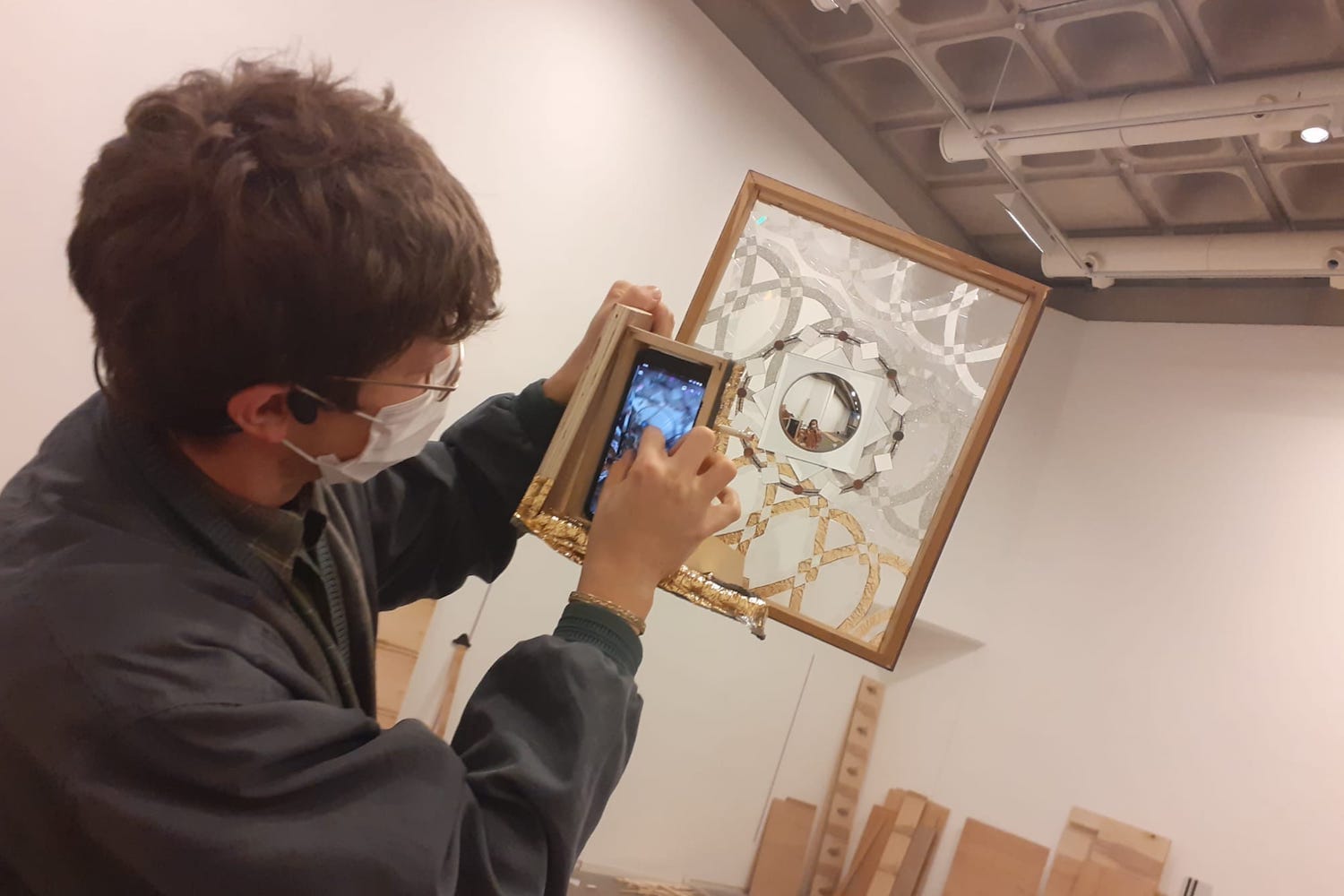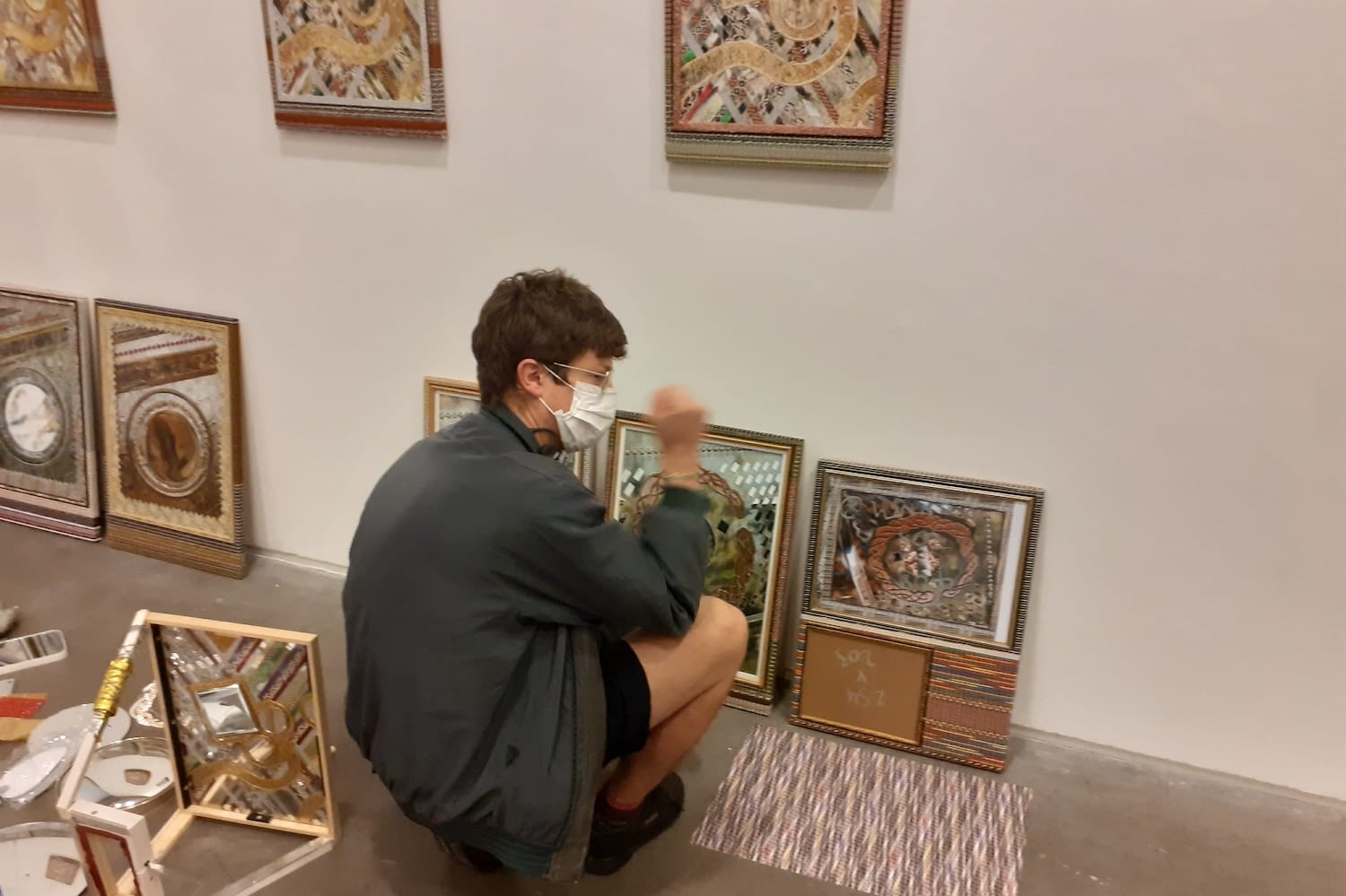What would become of the Civic Offices on Wood Quay if the council relocates?
After The Currency reported the idea of the council moving its HQ, councillors were talking about and thinking through the pros and cons and implications.
Three artists are using corners of the gallery as their studios, creating works that will be on show there when the exhibition From Here to There opens later this month.

Staff glancing from a high-up balcony down into the well of the main gallery space at the Douglas Hyde Gallery at Trinity College Dublin on a recent Wednesday could see artist David Lunney, sat alone in the furthest corner of the huge gallery.
His back was arched over his drawing, a colourful criss-cross of designs with a forest at the centre in a fish-eye frame, which was round like a bauble.
Now and then, he glanced at a laptop on a nearby chair which showed a photo, he was trying to, almost exactly, copy.
His paintings are stacked or hang on one wall. Boxes of wool, rope, and glittery beads surround him and give him some privacy within the vast space – but not much.
With its latest exhibition, From Here to There, the gallery has handed over its space to three artists – Lunney, Áine McBride and Katie Watchorn – for six weeks. They’re each using a corner of the room as a studio space, to create the work that will be on show when the exhibition opens on 28 October.
Visitors have been welcome to stop in on Saturdays for what the staff say is an unstaged look at what really happens inside artists’ studios. Before seeing the final product in the exhibition.
“I like the idea of the transparency of the process, creating a place for people to connect with the exhibition, or with the artist,” says Fernando Sánchez-Migallón Cano, a curator at the gallery.
Lunney holds a wooden apparatus, almost like a hollowed-out daguerreotype camera, up above his head.
It is a picture frame with no picture, and wedged between the glass is instead a mirror surrounded by interwoven curls of shiny silver and sparkly gold paper, and gaps to see the world through.
His phone is attached to it, mounted (temporarily) at an angle, its camera’s lens peeking through the apparatus at the world. He taps the phone with his finger to snap a picture.
In the photo is the looking glass, showing the curved reflections of the gallery-turned-studio: his work desk, the unfinished painting, planks of wood, and the masked faces of Lunney and his interviewer standing beneath.
The design is Celtic-inspired, he says, because he loves the look of embellished and decorated art, like the Book of Kells, rococo style and lots of Indian and Chinese art.
“It’s only since modernism that the Western world has kind of turned away from that. But to my mind that’s silly,” he says. “I just love putting a super amount of decoration on everything.”
If he were going to use this photograph to create a completed work – one like what he might hang in the exhibition – he would draw or paint a hand-made version of it, nearly a replica, to display in an ornate frame.
That’s his process. Except usually it would involve a walk in the mountains, not just staying in the studio.
He’ll find his sparkly, gaudy materials, build his kaleidoscope frame, mount his phone and then go for a pleasant walk in the mountains, hunting for a secluded spot away from nosey dog walkers.
Luckily, he’s familiar with the mountains as he grew up nearby. “I walked around there as a kid and had it as my own personal playground.”
He’ll hold the photography apparatus up, pointing it this way and that, tapping the capture button on his phone’s camera.
The scraps or circles of mirrors within the frame will contain the world of forest, field or mountaintop, inside the studio-built ornate, embellished panes of glass – with gaps in the glass, to see the other side. “It’s almost trying to give this whole world, cohesive experience, through the medium of pattern,” he says.
Since the mountains are nostalgic for him, the drawing of the frame imbues the scene with Lunney’s own perspective. “I could show you a photograph from there, but that’s dull.”

Instead, on display in the gallery, the apparatus itself tells a story. “The object in its own right, sort of implies that journey, which I think is kind of an important part of the curatorial angle on this show as well, the title being From Here to There,” he says.
The mirrors and reflections create many stages of removal and complicated layers.
The bright designs, embellishment, reflective materials and colours show the mountain scene through the eyes of a sculptor, photographer, artist and framer all in one.
Lunney has only been to meet the public visitors on one Saturday so far, his time taken up by his newborn baby.
But when he did come in, he enjoyed it. “I was here chatting to people all day, as they came through,” he says. “That was fun, it was nice.”
In the final exhibition, he plans to display the photography apparatus as a sculpture near his paintings on the walls. Hopefully, people will make a connection between them, he says. “‘Ah, that’s how that was made, and he must have done this, and this.’”
Since the aim of his exhibition will be to leave hints so the visitor can figure out the process, he also doesn’t mind people coming in in the middle, and explaining how it works.
“It’s not like there’s any secrets,” he says.

This doesn’t happen with every exhibition though, says Sánchez-Migallón Cano, the learning and engagement curator at the Douglas Hyde Gallery.
He stands with his coworkers looking down at the vast art space and Lunney’s hunched, focused back sitting in the centre.
Office staff can watch over him all day long. “Make sure he’s working hard,” says Rachel McIntyre, the gallery manager, in jest.
Sánchez-Migallón Cano says other artists might prefer a closed door to their studio. “Keeping the secret of how they do things.”
Making art can be personal and some artists aren’t comfortable with the exposure. But “some people are happy to do it”, he says. “It’s a matter of finding artists that are more comfortable with open studio visits. It depends on the artists.”
Eoghan McIntyre, a gallery assistant, says an exhibition like this is good for art students, to see through an honest lens what the everyday work of an artist looks like. It’s different to an open studio, where an artist will typically give a tour of their space – tidied up, presentable, curated.
None of these artists have been cleaning up for the Saturday visits, as far as McIntyre can see, he says. “It’s a literal open studio, not one that is in any way performative.”
While many of Lunney’s finished frames already hang on the walls, in the two corners where McBride and Watchorn work, it’s still utterly unclear whether it is even art that is being made there.
Eoghan McIntyre will show visitors previous work by these artists, so they can find some meaning in the heaped materials.
“Basically there’s sort of hints, I would say, like you see with Áine’s work in this corner, with the tiles,” he says. “Just from being familiar with Áine’s work, I can guess at what that’s going to become.”
At the moment, the olive ceramic tiles could be the work of a tiler halfway through a bathroom wall. But “that’s what art is, until it becomes it”, says Eoghan.
Sánchez-Migallón Cano says the philosophy of witnessing the process of art will run throughout the exhibition. The artists will get to change what they’ve exhibited, maybe switching out a piece, or asking another artist to respond to their work.
There will be educational talks, and potentially a performance piece, he says. “It’s challenging that idea of the static exhibition of being one thing, one moment. It’s going to be multiple moments,” he says.
[CORRECTIONS: This article was updated at 2pm on 21 October to correct a surname and the position of one person. Apologies for the errors.]